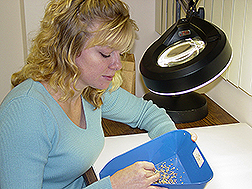Holding On to Finger Millet
|
|
Cultivating new plant varieties is serious business—providing food and feed as well as ornamental plants for use in homes and landscapes. But an important step in developing new plants is to preserve germplasm from the not-so-new varieties.
Agricultural Research Service agronomist Melanie Newman is the curator for finger millet and other warm-season cereals, forages, and turfgrasses. The finger millet collection, along with more than 83,400 samples of other agricultural crops, is held in the ARS Plant Genetic Resources Conservation Unit in Griffin, Georgia. There is just one species of finger millet (Eleusine coracana) in the collection—but 738 samples, or accessions, with several varieties among them.
"It's crucial to agriculture to have a collection of plant material with key genetic traits," says Newman. For example, salt tolerance or drought resistance in turfgrass would be needed if water restrictions were put in place. Yield and resistance to a fungal disease called blast are important traits for finger millet. "These traits may be found in the genetic material contained in the ARS collection and could be integrated into breeding programs to produce improved cultivars having those traits."
But first, she says, accurate identification of the accessions is essential if the collection is to be a reliable source of germplasm. Newman and plant geneticist Ming Li Wang are genetically fingerprinting the germplasm to provide a set of genetic markers scientists will use to identify various traits. The work will also help them eliminate any duplicates in the collection.
Plant geneticist Katrien Devos, of the University of Georgia in Athens, Georgia, says, "Access to finger millet germplasm is crucial to my research on biodiversity analysis and cultivar improvement. Having such a collection at my doorstep overcomes the practical problems associated with obtaining accessions directly from India and Africa. But most importantly, the collection is well characterized, which helps me select the most suitable materials for genetic studies and breeding applications."
Keeping the collection going means maintaining enough seeds of each accession. Seeds stored at the Griffin facility are germinated in special chambers, grown in pots in the greenhouse, and then planted in the field. Seeds from these plants are then preserved for future use. To back up the Griffin collection, seeds from each accession are sent to the ARS National Center for Genetic Resources Preservation in Fort Collins, Colorado.
Newman also receives requests for nutritional studies on finger millet because of its use as food in developing countries. While finger millet is a staple in parts of Africa and India, it's not high on the list for U.S. consumers. But that could change. "This grain is rich in calcium, iron, methionine, and tryptophan," says Newman. "And it can even be popped like popcorn. So perhaps it can find a niche here."—By Sharon Durham, Agricultural Research Service Information Staff.
This research is part of Plant, Microbial, and Insect Genetic Resources, Genomics, and Genetic Improvement (#301), an ARS National Program described on the World Wide Web at www.nps.ars.usda.gov.
Melanie Newman is in the USDA-ARS Plant Genetics Resources Conservation Unit, 1109 Experiment St., Griffin, GA 30223-1797; phone (770) 412-4097, fax (770) 229-3323.
"Holding On to Finger Millet" was published in the April 2005 issue of Agricultural Research magazine.







